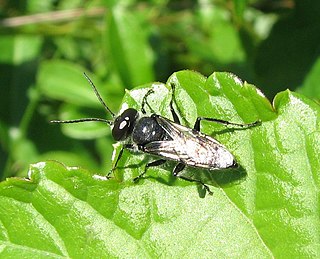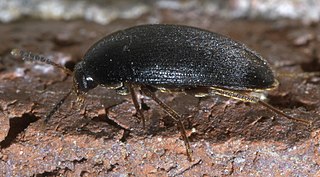
Sorghum bicolor, commonly called sorghum and also known as great millet, broomcorn, guinea corn, durra, imphee, jowar, or milo, is a species in the grass genus Sorghum cultivated for its grain. The grain is used for food for humans; the plant is used for animal feed and ethanol production. Sorghum originated in Africa, and is now cultivated widely in tropical and subtropical regions.

Christoph Waltz is an Austrian and German actor. Primarily active in the United States, he gained international recognition for his portrayal of villainous and supporting roles in English-language films. His accolades include two Academy Awards, two Golden Globe Awards, two BAFTA Awards, and two Screen Actors Guild Awards.

Astatidae is a cosmopolitan family of solitary wasps, peculiar for their males having very large compound eyes that broadly meet at the top of the head. The largest genus in this family is Astata, with about half of more than 160 species in the family.
Santiago Astata is a town and municipality in Oaxaca in south-western Mexico. It is part of the Tehuantepec District in the west of the Istmo Region. The name "Astata" means "place of herons".

Astata is a cosmopolitan genus of solitary predatory wasps in the family Astatidae. They are known to prey on adults and nymphs of Pentatomidae. Astata is the largest genus in this subfamily, and is identified by features of its wing venation. The males of this genus and the related genus Dryudella have very large compound eyes that broadly meet at the top of the head.
Astata occidentalis is a species of wasp in the family Astatidae. It is found in Central America and North America.
Astata unicolor is a species of wasp in the family Astatidae. It is found in Central America and North America. The species is sexually dimorphic, with males have black abdomens, while females are black and orange. It is a predator of Pentatomidae, including Halyomorpha halys, which is invasive to North America.

Merhynchites bicolor, the rose curculio, is a species of leaf rolling weevil in the beetle family Attelabidae. It is found in North America.
Agulla bicolor is a species of snakefly in the family Raphidiidae. It is found in North America.

Eustrophopsis bicolor is a species of polypore fungus beetle in the family Tetratomidae. It is found in the Caribbean Sea and North America.
Tytthonyx bicolor is a species of soldier beetle in the family Cantharidae. It is found in North America.
Ululodes bicolor is a species of owlfly in the tribe Ululodini. It is found in Central America and North America.
Chasmatonotus bicolor is a species of midge in the family Chironomidae.

Centromerita bicolor is a species of sheetweb spider in the family Linyphiidae. It is found in the United States, Canada, and Europe.

Chalepus bicolor is a species of leaf beetle in the family Chrysomelidae. It is found in the Caribbean Sea and North America.
Isonychia rufa is a species of brushlegged mayfly in the family Isonychiidae and the bicolor group. It was originally named by McDunnough in 1931. It is found in central North America, from southern Manitoba to Oklahoma. Isonychia rufa is commonly found in larger rivers and streams from the Mississippi drainage. Isonychia rufa can be distinguished from other species in the bicolor group through certain characteristics present in male imago. These include: whiteish and light yellowish veins in the forewing hyaline, dorsal penes with a relatively prominent basal swelling which forms lateral and apical ridges, bright red to reddish orange brown abdomen, and stigmatic cross veins.

Monotoma bicolor is a species of root-eating beetle in the family Monotomidae. It is found in Africa, Australia, Europe and Northern Asia, and North America.
Notolomus bicolor is a species of true weevil in the beetle family Curculionidae. It is found in North America.
Behrensia bicolor is a species of moth in the family Noctuidae. It is found in North America.

Kambo, also known as sapo or vacina-do-sapo, is substance derived from the natural secretions of an amphibian belonging to the Phyllomedusa family. Commonly the dried skin secretions of the giant leaf frog, known as the kambô in Portuguese, a species of frog, are used for ritualistic purposes with a strong religious and spiritual components. Less commonly it is used as a transdermal medicine, however, evidence for its effectiveness is limited.









